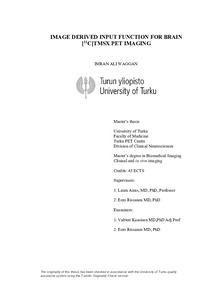IMAGE DERIVED INPUT FUNCTION FOR BRAIN [11C]TMSX PET IMAGING
Waggan, Imran (2019-04-05)
IMAGE DERIVED INPUT FUNCTION FOR BRAIN [11C]TMSX PET IMAGING
Waggan, Imran
(05.04.2019)
Julkaisu on tekijänoikeussäännösten alainen. Teosta voi lukea ja tulostaa henkilökohtaista käyttöä varten. Käyttö kaupallisiin tarkoituksiin on kielletty.
avoin
Julkaisun pysyvä osoite on:
https://urn.fi/URN:NBN:fi-fe2019051015083
https://urn.fi/URN:NBN:fi-fe2019051015083
Tiivistelmä
Modeling and analysis of positron emission tomography (PET) imaging data requires the critical information of the input function of the radioligand used. In PET imaging of the brain, the ‘gold standard’ for acquiring input function is to estimate the metabolite corrected arterial plasma input of the used radioligand as a function of time via arterial cannulation, i.e. to use the so-called original arterial input function (OAIF) method. Arterial cannulation, however, is unpleasant for the patient, invasive, requires expertise and additional resources. Consequently, it discourages patients and healthy subjects to enroll into clinical PET studies. To counter these problems, the feasibility of an alternative method for acquiring input function from the PET image, image-derived input function (IDIF), was evaluated for brain PET imaging with [11C]TMSX radioligand in this thesis. [11C]TMSX is a radioligand binding selectively to adenosine A2A-receptors. The method was implemented on data from 45 study subjects (9 healthy controls, 19 Parkinson’s disease patients and 17 multiple sclerosis patients) imaged with [11C]TMSX and High Resolution Research Tomograph (HRRT) PET scanner in earlier studies in Turku PET Centre. The results showed significant differences between the level of IDIF and OAIF values although with a high correlation. Image derived input function acquisition method that was used in this study is therefore not reliable enough to substitute original arterial input function. Alternative IDIF extraction methods should be investigated for this purpose in the future.
